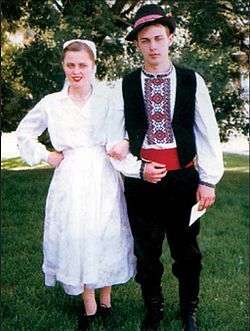Rusyns
Rusyns (Rusyn: Русины / Rusynŷ), sometimes referred to as Rusnaks (Rusyn: Руснакы / Rusnakŷ) (Slovak: Rusnáci), also known as Ruthenians, Carpatho-Ruthenians or Carpatho-Russians (Rusyn: Карпато-Русини / Karpato-Rusyny), are an East Slavic people who speak the Rusyn language. They descend from an East Slavic population that inhabited the northern regions of the Eastern Carpathians from the Early Middle Ages. Together with other East Slavs from neighboring regions, they were often labeled by the common exonym Ruthenians,[14] or by the regionally more specific designation Carpathian Ruthenians, with subgroup designations such as Dolinyans, Boykos, Hutsuls and Lemkos. Unlike their neighbors to the east, who adopted the use of the ethnonym Ukrainians in the early 20th century, Rusyns kept and preserved their original name. As residents of northeastern regions of the Carpathian Mountains, Rusyns are closely connected to, and also sometimes associated with, other Slavic communities in the region, like the West Slavic highlander community of Gorals (literally 'Highlanders'). The use of Rusyn ethnonym is highly politicized, particularly due to the irredentist thought in modern Russia that considers the Ruthenian nation part of the nation of Great Russians.
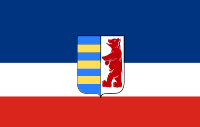 Flag of Rusyns, promulgated by the Academy of Rusyn Culture[1]  Coat of arms of Carpathian Ruthenia, adopted by some Rusyns | |
| Total population | |
|---|---|
| 623,500[2] | |
| Regions with significant populations | |
| 33,482[3] | |
| 10,183–32,386[4] | |
| 14,246[5] | |
| 8,934-320,000 (ancestry)[note 1][6] | |
| 2,879[7] | |
| 2,342[8] | |
| 1,109[9] | |
| 638–10,531[note 2][10] | |
| 200–4,090[note 3][11][12][13] | |
| Languages | |
| Rusyn · Ukrainian · Slovak Serbian · Hungarian | |
| Religion | |
| Mostly Greek Catholic (Ruthenian Greek Catholic Church), Ukrainian Greek Catholic Church; with Eastern Orthodox (Russian Orthodox Church, Serbian Orthodox Church and American Carpatho-Russian Orthodox Diocese) | |
| Related ethnic groups | |
| Other Ruthenians (Ukrainians · Lemkos · Hutsuls) | |
The main regional designations for Rusyns are Carpatho-Rusyns, Carpatho-Ruthenians and Carpatho-Russians, with the "Carpatho-" prefix referring to Carpathian Ruthenia (Rusynia), a historical cross-border region encompassing southwestern parts of modern Ukraine, northeastern regions of Slovakia, and southeastern parts of Poland. Of the estimated 1.2–1.6 million people of Rusyn origin, only around 90,000 have been officially identified as such in recent national censuses. That is because many census-taking authorities regard them as a subgroup of Ukrainian people, but some countries officially recognize them as an ethnic minority.
Etymology
The term Rusyns (rusyny) is derived from Rus' (Ruthenia) and has been widely used for centuries for East Slavs inhabiting Carpathian Rus'.[15][16] Since the 18th century, after the Partitions of Poland the term Ruthenian "came to be associated primarily with those Ukrainians who lived under the Habsburg monarchy" (since 1843 used as an official designation in the Austrian Empire) and since early 20th century "became even more restricted: it was generally used to refer to the inhabitants of Transcarpathia and to Transcarpathian emigrants in the United States", for whom the terms Rusyn and Carpatho-Rusyn are more commonly used since the 1970s.[17] In the Kingdom of Hungary, officially the term Ruthenians was used for the Rusyns of Transcarpathia until 1945.[18] The terms Rusyn, Ruthenes, Rusniak, Lemak, Lyshak, and Lemko are considered by some scholars to be historic, local and synonymical names for the inhabitants of Transcarpathia; others hold that the terms Lemko and Rusnak are simply regional variations of Rusyn or Ruthene.[15]
Origins
There are different theories to explain Rusyn origins.[19] According to Paul Robert Magocsi, the origin of the present-day Carpatho-Rusyns is complex and not exclusively related to the Kievan Rus'. The ancestors were the early Slavs whose movement to the Danubian Basin was influenced by the Huns and Pannonian Avars between the 5th and 6th centuries, the White Croats who lived on both slopes of the Carpathians and built many hill-forts in the region including Uzhhorod ruled by the mythical ruler Laborec, the Rusyns of Galicia and Podolia, and Vlachian shepherds of Transylvania.[20][21] George Shevelov also considered a connection with East Slavic tribes, more specifically, the Hutsuls, and possibly Boykos, argued to be the descendants of the Ulichs who were not native in the region.[22] As the region of the Ukrainian Carpathians, including Zakarpattia and Prykarpattia, has since the Early Middle Ages been inhabited by the tribes of Croats,[Note 4] in Ukrainian encyclopedias and dictionaries, and the Great Russian Encyclopedia, the Rusyns are generally considered to be the descendants of the White Croats.[Note 5]
Anthropology
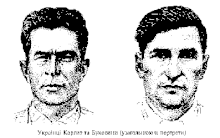
According to anthropological studies, the Eastern Carpathian population makes one of the sub-regional clines of the Ukrainian population, which can be regionally divided into Eastern and Western Carpathian variants. In the study by M. S. Velikanova (1975) the skulls from a medieval necropolis near village Vasyliv in Zastavna Raion were very similar to contemporary Carpathian population, and according to S. P. Segeda, V. Dyachenko and T. I. Alekseyea this anthropological complex developed in the Middle Ages or earlier, as descendants of the medieval Slavs of Galicia and carriers of Chernyakhov culture along Prut-Dniester rivers, possibly with some Thracian component. According to data, the population has the lowest admixture in Ukraine of Turkic speaking populations, like Volga Tatars and Bashkirs, while in comparison to other populations they have similarities with neighbouring Eastern Slovaks, Gorals of Poland, Romanians, some groups of Czechs and Hungarians, Northwestern Bulgarians, Central and Northern Serbians, and most of Croatians.[23][24]
Population genetics
The 2006 mitochondrial DNA study of Carpathian Highlanders - Boykos, Hutsuls and Lemkos people - showed a common ancestry with other modern Europeans.[25] A 2009 mitochondrial DNA study of 111 samples found that in comparison to eight other Central and Eastern European populations (Belorussian, Croatian, Czech, Hungarian, Polish, Romanian, Russian, Ukrainian), the three Rusyn groups have a greater distance between themselves than these populations, with Boykos showing the greatest distance from all and did not cluster with anyone because have atypically low frequencies of haplogroup H (20%) and J (5%) for a European population, while Lemkos are closest to the Czech and Romanian (0.17) population, and Hutsuls closest to the Croatian (0.11) and Ukrainian (0.16) population.[26]
The 2014 Y-DNA studies of 200 Pannonian Rusyns in the region of Vojvodina, Serbia, found they mostly belong to haplogroup R1a (43%), I2 (20%), E-V13 (12.5%), and R1b (8.5%), while I1, G2a, J2b, N1 between 2.5-4.5%, and J1, T, and H only in traces of less than 1%.[27] They cluster closest to the Ukrainian and Slovakian population, "providing evidence for their genetic isolation from the Serbian majority population".[28] The 2015 Y-DNA study of 150 men from Zakarpattia and Chernivtsi Oblast (Bukovina), found they mostly belong to R1a1a1*(М198), I2a (Р37.2), R1a1a1 (М458) ranging around and less than 30%, with E1b1b1a1 (M78), R1b1b2 (M269), and I1 (М253) ranging between 4-14%. The sampled population is most similar to other Ukrainians, while the Bukovina population slightly "differs from the typical Ukrainian population" because it has the highest percentage of I2a (>30%) and the lowest percentage of R1a (30%) in Ukraine. Bukovina's percentage of I2 is similar to near Moldovan and Romanian population, while the highest percentage is among South Slavs in Western Balkans. It was concluded that although bordered by diverse nations, the Carpathians seemingly were a barrier decreasing gene flow southward of N1c (М178), R1a (М198) from the region, and northward of E1b (М78), R1b (М269), J (М304) and G (М201) to the region.[29]
Modern history


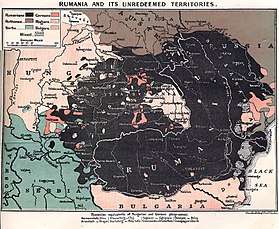
.jpg)
The Rusyns have always been subject to larger neighboring powers, but in the 19th century a Rusyn national movement was formed which emphasized distinctive ethnic identity and literary language.[30] During the Spring of Nations on 2 May 1848 in Lemberg (today Lviv) was established the first political representation of the Galician Rusyns, the Main Ruthenian Council (Rusyn: Головна Руська Рада, Holovna Ruska Rada).[31] The most active and leading stratum among Rusyns was Greek-Catholic clergy (see Greek Catholic Eparchy of Mukachevo, Ruthenian Greek Catholic Church, a successor of Ecclesia Ruthena unita).[31]
During the Dissolution of Austro-Hungarian Monarchy (1918),[32] various parts of Rusyn people were faced with different political challenges. Those who lived in northeastern counties of the Hungarian part of the former Monarchy were faced with pretensions of Hungary, Romania, and Czechoslovakia. On the other hand, those who lived in the former Kingdom of Galicia and Lodomeria were faced with pretensions of Poland and Ukraine.[33]
Rusyns formed two ephemeral states after World War I: the Lemko-Rusyn Republic and Komancza Republic. Prior to this time, some of the founders of the Lemko-Rusyn Republic were sentenced to death or imprisoned in Talerhof by the prosecuting attorney Kost Levytsky (Rusyn: Кость Леви́цький), future president of the West Ukrainian National Republic.[30][34] In the interwar period, the Rusyn diaspora in Czechoslovakia enjoyed liberal conditions to develop their culture (in comparison with Ukrainians in Poland or Romania).[35]
In the 1920s and 1930s a dispute existed between Russophile and Ukrainophile Rusyns.[30] In October 1938, a series of political reforms were initiated, leading to the creation of the Second Czechoslovak Republic, consisting of three autonomous political entities, one of them being the Subcarpathian Rus' (Rusyn:Подкарпатских Русь). On 11 October 1938, first autonomous Government of Subcarpathian Rus was appointed, headed by prime-minister Andrej Bródy. Soon after, a crisis occurred between pro-Rusyn and pro-Ukrainian fractions, leading to the fall of Bródy government on 26 October. New regional government, headed by Avgustyn Voloshyn, adopted a pro-Ukrainian course and opted for the change of name, from Subcarpathian Rus' to Carpathian Ukraine.[33]
That move led to the creation of a particular terminological duality. On 22 November 1938, authorities of the Second Czechoslovak Republic proclaimed the Constitutional Law on the Autonomy of Subcarpathian Rus' (Czech: Ústavní zákon o autonomii Podkarpatské Rusi), officially reaffirming the right of self-determination of Rusyn people (preamble), and confirming full political and administrative autonomy of Subcarpathian Rus', with its own assembly and government. In the constitutional system of the Second Czechoslovak Republic, the region continued to be known as the Subcarpathian Rus', while local institutions promoted the use of the term Carpathian Ukraine.[33]
The Republic of Carpatho-Ukraine, which existed for one day on March 15, 1939, before it was occupied and annexed by Hungary, is sometimes considered to have been a self-determining Rusyn state that had intentions to unite with Kiev. The Republic's president, Avgustyn Voloshyn, was an advocate of writing in Rusyn. The Hungarian annexation caused support for Russophile direction, while in Germany occupied Poland support for Ukrainian identity.[30] In 1947, under the Operation Vistula happened forced resettlement of c. 150,000 Lemkos, Boykos and other Ukrainians between Poland and Ukraine. In the same time some 8,500 Rusyns voluntarily emigrated from Czechoslovakia to Ukraine, but more than half of them returned during the 1960s.[30]
After World War II, they were declared as a part of the Ukrainians.[30] By the end of the 20th century appeared many societies and organizations considering Rusyns as people separate from Ukrainians. By the early 21st century they had representatives in parliaments of Serbia, Hungary, and Romania, have published own press, and in 2007 was opened Museum of Ruthenian Culture in Prešov, Slovakia.[30]
Autonomist and separatist movements
A considerable controversy has arisen regarding the Rusyn separatist movement led by the Orthodox priest Dimitry Sydor (now Archbishop of Uzhorod, in the Ukrainian Orthodox Church (Moscow Patriarchate)), his relationship with the Russian Orthodox Church and funding for his activities.[36][37] Russia has, as a result of the Russian census of 2002, recognized the Rusyns as a separate ethnic group in 2004, and has been accused by the Ukrainian government of fueling ethnic tensions and separatism among Rusyns and Ukrainians.[38]
A criminal case under Part 2, Art. 110 of the Ukrainian Criminal Code was initiated after the 1st European Congress of Rusyns took place in Mukachevo on June 7, 2008. At that particular Congress, it was recognized the reinstating of the Zakarpattia's special status as special "territory of Rusyns to the south of the Carpathians" with self-government under the constitutional name Subcarpathian Rus. On October 29, in Mukachevo at a 2nd Congress, a memorandum was signed calling for the authorities to recognize the Subcarpathian Rus autonomy (by December 1). That same day, according to the Kommersant-Ukraine (Ukrainian edition) agents of the Security Service of Ukraine (SBU) questioned Dmytro Sydor and Yevgeniy Zhupan. They were summoned to SBU as witnesses in a criminal case "on the infringement on territorial integrity of Ukraine" initiated in June 2008.[39]
Research conducted by the University of Cambridge during the height of political Rusynism in the mid-1990s that focused on five specific regions within the Zakarpattia Oblast having the strongest pro-Rusyn cultural and political activism, found that only nine percent of the population of these areas claimed Rusyn ethnicity.[40][41] These numbers may change with the further acceptance of Rusyn identity and the Rusyn language in educational systems in the area; nevertheless in the present day, according to the Ukrainian census, most – over 99% – of the local inhabitants consider themselves to be Ukrainians.[4]
Religion
In 1994, the historian Paul Robert Magocsi stated that there were approximately 690,000 Carpatho-Rusyn church members in the United States, with 320,000 belonging to the largest Greek Catholic affiliations, 270,000 to the largest Eastern Orthodox affiliations, and 100,000 to various Protestant and other denominations.[42]
Greek Catholics
Most Rusyns are Eastern Catholics of the Byzantine Rite, who since the Union of Brest in 1596 and the Union of Uzhhorod in 1646 have been in communion with the See of Rome.[43][44][45] They have their own particular Church, the Ruthenian Greek Catholic Church, distinct from the Latin Catholic Church. It has retained the Byzantine Rite liturgy, sometimes including the Old Church Slavonic language, and the liturgical forms of Byzantine or Eastern Orthodox Christianity.
The Pannonian Rusyns of Croatia are organized under the Greek Catholic Eparchy of Križevci, and those in the region of Vojvodina (northern Serbia), are organized under the Greek Catholic Eparchy of Ruski Krstur, headed by bishop Đura Džudžar, who is an ethnic Rusyn. Those in the diaspora in the United States established the Byzantine Catholic Metropolitan Church of Pittsburgh.
Eastern Orthodox
Although originally associated with the Eastern Orthodox Eparchy of Mukachevo, that diocese was suppressed after the Union of Uzhhorod. New Eastern Orthodox Eparchy of Mukachevo and Prešov was created in 1931 under the auspices of the Serbian Orthodox Church.[46] That eparchy was divided in 1945, eastern part joining Russian Orthodox Church as the Eparchy of Mukachevo and Uzhhorod, while western part was reorganized as Eastern Orthodox Eparchy of Prešov of the Czech and Slovak Orthodox Church. The affiliation of Eastern Orthodox Rusyns was adversely affected by the Communist revolution in the Russian Empire and the subsequent Iron Curtain which split the Orthodox diaspora from the Eastern Orthodox believers living in the ancestral homelands. A number of émigré communities have claimed to continue the Orthodox Tradition of the pre-revolution church while either denying or minimizing the validity of the church organization operating under Communist authority. For example, the Orthodox Church in America (OCA) was granted autocephalous (self-governing) status by the Moscow Patriarchate in 1970. Although approximately 25% of the OCA was Rusyn (referred to as "Ruthenian") in the early 1980s, an influx of Eastern Orthodox émigrés from other nations and new converts wanting to connect with the Eastern Church have lessened the impact of a particular Rusyn emphasis in favor of a new American Orthodoxy.
Many Rusyn Americans left Catholicism for Eastern Orthodoxy in the 19th century due to disputes with the Latin Church bishops, who viewed different practices in the Byzantine Rite (such as married clergy) with suspicion. After a bitter fight with Archbishop John Ireland, Father Alexis Toth, himself a Rusyn from Hungary, converted to Eastern Orthodoxy and eventually led as many as 20,000 Rusyn-Americans from Catholicism into Eastern Orthodoxy, for which he was canonized by the Orthodox Church.
Another large segment of Rusyn Americans belong to the American Carpatho-Russian Orthodox Diocese, which is headquartered in Johnstown, Pennsylvania. From its early days, this group was recognized by the Ecumenical Patriarchate as a self-governing diocese.
Location
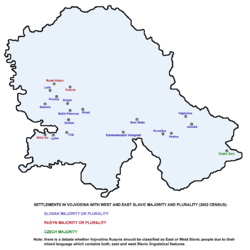
Those who use the ethnonym Rusyn for self-identification are primarily people living in the mountainous Transcarpathian region of Western Ukraine and adjacent areas in Slovakia who use it to distinguish themselves from Ukrainians living in the central regions of Ukraine.
Those Rusyns who self-identify today have traditionally come from the Eastern Carpathians. This region is often referred to as Carpathian Ruthenia. Since mid-18th century there are resettled Rusyn communities located in the Pannonian Plain, parts of present-day Serbia (particularly in Vojvodina – see also Ethnic groups of Vojvodina), as well as present-day Croatia (in the region of Vukovar-Srijem County).[30] Rusyns also migrated and settled in Prnjavor, a town in the northern region of present-day Bosnia and Herzegovina. Around 225,000 Rusyns emigrated to the United States and Canada at the end of the 19th and early 20th century.[30]
Demography
Of the estimated 1.2–1.6 million people of Rusyn origins,[15][30] only around 90,000 individuals have been officially identified as such in recent national censuses (see infobox above). This is due, in part, to the refusal of some governments to count Rusyns and/or allow them to self-identify on census forms, especially in Ukraine.[47] The ethnic classification of Rusyns as a separate East Slavic ethnicity distinct from Russians, Ukrainians, or Belarusians is, consequently, politically controversial.[48][49][50] The majority of scholars on the topic consider Rusyns to be an ethnic subgroup of the Ukrainian people.[51][52] This is disputed by some non-mainstream scholars,[53] as well as other scholars from the Czech Republic, Slovakia, Canada, and the United States. According to the 2001 Ukrainian Census, thirty percent of Rusyns in Ukraine identified Ukrainian as their native language, while two thirds named the Rusyn language.[54] However, about 10 thousand people, or 0.8%, of Ukraine's Zakarpattia Oblast (Province) identified themselves as Rusyns; by contrast, over 1 mllion considered themselves Ukrainians.[4]
The endonym Rusyn has frequently gone unrecognised by various governments, and has in other cases been prohibited.[15] Today, Slovakia, Poland, Hungary, the Czech Republic, Serbia and Croatia officially recognize contemporary Rusyns as an ethnic minority.[55] In 2007, Carpatho-Rusyns were recognized as a separate ethnicity in Ukraine by the Zakarpattia Oblast Council on a regional level,[30] and in 2012 the Rusyn language gained official regional status in certain areas of the province, as well as nationwide based on the 2012 Law of Ukraine, "On the principles of the state language policy". However, most contemporary self-identified ethnic Rusyns live outside of Ukraine.
Ethnic subgroups
Rusyns subgroups are Carpathian Rusyns, mostly from Carpathian Ruthenia who speak the Carpathian Rusyn language,[56] and Pannonian Rusyns, mostly from Voivodina who speak the Pannonian Rusyn language. Other more specific ethnic groups with regional identity are Dolinyans,[30] Lemkos who are considered as a distinct ethnic minority in Slovakia or with some ethnic recognition in Poland, but both with Boykos and Hutsuls are considered as part of Ukrainian nationality in Ukraine.[26][57][58][59] Some scholars also regarded them as a Vlach minority.[60]
Image gallery
Notes
- Respondents in the U.S. census identified as Carpatho Rusyn
- According to the 2011 Polish census, 10,531 respondents identified as Lemkos, separately from Rusyns.
- While an estimated 200 people identified themselves as "Rusyns" in 2011, in the 2002 Romanian census, 3,890 people identified as Hutsuls (Romanian: Huțuli; Rusyn Hutsuly) – a minority whose members often identify as or are regarded as a subgroup of the Rusyns. A further 61,091 Romanian citizens identified as Ukrainian (Romanian: Ucraineni). As the archaic exonym "Ruthenians" was applied indiscriminately to both Rusyns and Ukrainians, some Ukrainian-Romanians may also regard themselves as Rusyns in the sense of a subgroup of a broader Ukrainian identity.
References
- "Academy of Rusyn Culture in the Slovak Republic: Rusyn Symbols". Academy of Rusyn Culture in the Slovak Republic. Retrieved 17 October 2019.
- Rusyn at Ethnologue (18th ed., 2020)
- "Permanently resident population by nationality and by regions and districts" (PDF) (in Slovak). Statistical Office of the Slovak Republic. 2011. Archived from the original (PDF) on 2012-04-17.
- Чисельність осіб окремих етнографічних груп украінського етносу та їх рідна мова [Number of persons individual ethnographic groups of the Ukrainian ethnicity and their native language]. ukrcensus.gov.ua (in Ukrainian). 2001. Retrieved 4 March 2016. Карта говорiв української мови, 10.10.2008; Энциклопедический словарь: В 86 томах с иллюстрациями и дополнительными материалами. Edited by Андреевский, И.Е. − Арсеньев, К.К. − Петрушевский, Ф.Ф. − Шевяков, В.Т., s.v. Русины. Online version. Вологда, Russia: Вологодская областная универсальная научная библиотека, 2001 (1890−1907), 10.10.2008; Ethnologue: Languages of the World. Edited by Gordon, Raymond G., Jr., s.v. Rusyn. Fifteenth edition. Online version. Dallas, Texas, U.S.A.: SIL International, 2008 (2005), 10.10.2008; Eurominority: Peoples in search of freedom. Edited by Bodlore-Penlaez, Mikael, s.v. Ruthenians. Quimper, France: Organization for the European Minorities, 1999–2008, 10.10.2008.
- Становништво према националној припадности [Population by ethnicity]. Serbian Republic Institute of Statistics (in Serbian). Archived from the original on 2013-04-16.
- "Total ancestry categories tallied for people with one or more ancestry categories reported, 2010 American Community Survey, 1-Year Estimates". United States Census Bureau. Archived from the original on February 12, 2020. Retrieved November 30, 2012.
- "STANOVNIŠTVO PREMA NARODNOSTI, PO GRADOVIMA/OPĆINAMA, POPIS 2001" [Population by ethnicity in cities and municipalities, 2001 Census] (in Croatian). State Institute for Statistics of the Republic of Croatia.
- Vukovich, Gabriella (2018). Mikrocenzus 2016 - 12. Nemzetiségi adatok [2016 microcensus - 12. Ethnic data] (PDF). Hungarian Central Statistical Office (in Hungarian). Budapest. ISBN 978-963-235-542-9. Retrieved 9 January 2019.
- "Rusínská národnostní menšina". Retrieved 18 March 2015.
- "Ludność. Stan i struktura demograficzno społeczna" [State and structure of the social demographics of the population] (PDF). Central Statistical Office of Poland (in Polish). 2013. p. 91. Retrieved 14 April 2013.
- Moser, Michael (2016). "Rusyn". In Tomasz Kamusella; Motoki Nomachi; Catherine Gibson (eds.). The Palgrave Handbook of Slavic Languages, Identities and Borders. Basingstoke UK: Palgrave Macmillan. p. 132.
- "Populaţia după etnie" (PDF) (in Romanian). Institutul Naţional de Statistică. Retrieved 2011-10-28.
- "Date naţionale" (in Romanian). Erdélyi Magyar Adatbank. Archived from the original on 2011-09-29. Retrieved 2011-10-28.
- Himka, John-Paul. "Ruthenians". www.encyclopediaofukraine.com. Internet Encyclopedia of Ukraine.
- Paul Magocsi (1995). "The Rusyn Question". Political Thought. 2–3 (6).
- Paul Robert Magocsi (2015). "Rusyn". Status since the end of World War II. Encyclopædia Britannica.
Rusyn, Rusyn ruskyi, also called Ruthenian, Carpatho-Rusyn, Lemko, or Rusnak, any of several East Slavic peoples (modern-day Belarusians, Ukrainians, and Carpatho-Rusyns) and their languages
- John-Paul Himka (2001) [1993]. Ruthenians. Internet Encyclopedia of Ukraine. 4. University of Toronto Press. ISBN 9781442632899.
- Udvari, István (7 March 2017). "Kultúra és hagyományok". www.rusyn.hu. Országos Ruszin Önkormányzat - Вседержавноє Русинськоє Самосправованя.
- Motta, Giuseppe (2014). Less than Nations: Central-Eastern European Minorities after WWI, Volumes 1 and 2. Cambridge Scholars Publishing. p. 156. ISBN 978-1-4438-5859-5.
There were different theories to explain the presence of Rusyns. In his The settlements, economy and history of the Rusyns of Subcarpathia (1923) A. Hodinka wondered if Russians arrived before the Magyars, at the same time or later? Were they White Croats? Slavs who mixed with nomad Vlachs?
- Magocsi, Paul Robert (1995). "The Carpatho-Rusyns". Carpatho-Rusyn American. XVIII (4).
The purpose of this somewhat extended discussion of early history is to emphasize the complex origins of the Carpatho-Rusyns. They were not, as is often asserted, exclusively associated with Kievan Rus', from which it is said their name Rusyn derives. Rather, the ancestors of the present-day Carpatho-Rusyns are descendants of: (1) early Slavic peoples who came to the Danubian Basin with the Huns; (2) the White Croats; (3) the Rusyns of Galicia and Podolia; and (4) the Vlachs of Transylvania.
- Magocsi, Paul R. (30 July 2005). Our people: Carpatho-Rusyns and their descendants in North America. Bolchazy-Carducci Publishers. p. 5. ISBN 9780865166110.
- George Shevelov (2002) [1979]. "A Historical Phonology of the Ukrainian Language" (in Ukrainian). Retrieved 2008-07-23.
Говорячи про Україну, слід брати до уваги такі доісторичні слов’янські племена, перелічені та/або згадані в Київському Початковому літописі, як деревляни (Середнє Полісся), сіверяни (Східне Полісся), поляни (Київщина, цебто ядро Русі), бужани (називані також волинянами або дулібами), уличі або улучі, тиверці (Подністров’я) та хорвати (Карпати? Перемищина?). Дуліби востаннє згадуються в записі за 907 р., уличі за 922 р., поляни й тиверці за 944 р., деревляни за 990 р., хорвати за 992 р., сіверяни за 1024 р. Дивлячись суто географічно, середньополіські говірки можуть бути виведені від деревлян, східнополіські від сіверян, західноволинські від дулібів; висловлено також гіпотезу, обстоювану — з індивідуальними нюансами — низкою вчених (Шахматовим, Лєр-Сплавінським, Зілинським, Нідерле, Кобилянським та ін.), що гуцули, а можливо й бойки, є нащадками уличів, які під тиском печенігів залишили свої рідні землі над Богом, переселившися до цієї частини карпатського реґіону. Проте нам нічого не відомо про мовні особливості, якими відрізнялися між собою доісторичні слов’янські племена на Україні, а отже будь-які спроби пов’язати сучасні говірки зі згаданими племенами ані довести, ані, навпаки, спростувати незмога.
- Segeda, Sergei Petrovich (1999). "Антропологічний склад українців Східних Карпат". Етногенез та етнічна історія населення Українських Карпат (in Ukrainian). 1. Lviv: Institute of Ethnology of the National Academy of Sciences of Ukraine. pp. 461–482.
- Segeda, Sergei Petrovich (2001). "Антропологічний склад українського народу". Antropolohiíà: navchal'nyĭ posibnyk dlíà studentiv humanitarnykh spet́s̀ial'nosteĭ vyshchykh navchal'nykh zakladiv (in Ukrainian). Kiev: Lybid. ISBN 966-06-0165-4.
- Willis, Catherine (2006). "Study of the Human Mitochondrial DNA Polymorphism". McNair Scholars Journal. 10 (1). Retrieved 2009-06-21.
- Nikitin, Alexey G.; Kochkin, Igor T.; June, Cynthia M.; Willis, Catherine M.; Mcbain, Ian; Videiko, Mykhailo Y. (2009). "Mitochondrial DNA sequence variation in Boyko, Hutsul and Lemko populations of Carpathian highlands". Human Biology. 81 (1): 43–58. doi:10.3378/027.081.0104. PMID 19589018.
- Veselinovic; et al. (2014). "Genetic polymorphism of 17 Y chromosomal STRs in the Rusyn population sample from Vojvodina Province, Serbia". International Journal of Legal Medicine. 128 (2): 273–274. doi:10.1007/s00414-013-0877-9. PMID 23729201.
- Rębała; et al. (2014). "Northern Slavs from Serbia do not show a founder effect at autosomal and Y-chromosomal STRs and retain their paternal genetic heritage". Forensic Science International: Genetics. 8 (1): 126–131. doi:10.1016/j.fsigen.2013.08.011. PMID 24315599. Retrieved 10 November 2018.
- O. M. Utevska; M. I. Chukhraeva; A. T. Agdzhoyan; L. A. Atramentova; E. V. Balanovska; O. P. Balanovsky (2015). "Populations of Transcarpathia and Bukovina on the genetic landscape of surrounding regions". Regulatory Mechanisms in Biosystems. 6 (2): 133–140. doi:10.15421/021524. PMID 23879710.
- М. Ю. Дронов (2016). РУСИ́НЫ. Great Russian Encyclopedia (in Russian). Bolshaya Rossiyskaya Entsiklopediya, Russian Academy of Sciences.
В этногенезе Р. приняли участие потомки племени белых хорватов, выходцы из др. вост.–слав. земель и др.
- Ihor Melnyk. Main Ruthenian Council (Головна Руська Рада). Zbruc. 30 April 2013
- PRECLÍK, Vratislav. Masaryk a legie (Masaryk and legions), váz. kniha, 219 pages, first issue - vydalo nakladatelství Paris Karviná, Žižkova 2379 (734 01 Karvina, Czech Republic) ve spolupráci s Masarykovým demokratickým hnutím (Masaryk Democratic Movement, Prague), 2019, ISBN 978-80-87173-47-3, pp. 87 - 89, 110 - 112, 124 - 128,140 - 148,184 - 209
- Rychlík & Rychlíková 2016.
- Vavrik, Vasilij Romanowicz (2001). Terezin i Talergof : k 50-letnej godovščine tragedii galic.-rus. naroda (in Russian). Moscow: Soft-izdat. OCLC 163170799. Archived from the original on 2010-12-23. Retrieved 2009-06-21.
- Orest Subtelny, Ukraine. A History. Second edition, 1994. p. 350-351. Subtelny treats transcarpathian Rusyns as a group of Ukrainians
- Дмитрий Сидор отказался давать показания СБУ и "наехал" на журналистов [Dmitry Sydorov refused to give evidence to a Ukrainian Security Services investigation and "struck back" at journalists]. ua-reporter.com (in Russian). 19 November 2008. Retrieved 20 March 2015.
- ПОЛІТИЧНЕ РУСИНСТВО І ЙОГО СПОНСОРИ [Political Rusynism and its sponsors]. ua-reporter.com (in Ukrainian). 11 July 2009. Retrieved 19 March 2015.
- Україна в лещатах російських спецслужб [Ukraine is in the grip of Russian secret services]. radiosvoboda.org (in Ukrainian). 25 December 2011. Retrieved 3 March 2016.
- Лідерів русинів допитали в СБУ [Leaders of Rusyns were questioned at the SBU]. ua.glavred.info (in Ukrainian). 30 October 2008. Archived from the original on 8 July 2011.
- Taras Kuzio (2005). The Rusyn Question in Ukraine: Sorting Out Fact from Fiction. Archived 2009-03-27 at the Wayback Machine Canadian Review of Studies in Nationalism, XXXII
- Political and Ethno-Cultural Aspects of the Rusyns’ problem: A Ukrainian Perspective - by Natalya Belitser, Pylyp Orlyk Institute for Democracy, Kyiv, Ukraine
- Magocsi, Paul R (1994). Our People: Carpatho-Rusyns and Their Descendants in North America. Toronto: Multicultural History Society of Ontario. ISBN 9780919045668. OCLC 30973382.
- Pekar 1979.
- Litwin 1987, p. 57–83.
- Véghseő 2015, p. 147-181.
- Eastern Churches Journal: A Journal of Eastern Christendom, vol. 4 (1997), p. 61
- "Законодавство України не дозволяє визнати русинів Закарпаття окремою національністю". Retrieved 18 March 2015.
- Professor Ivan Pop: Encyclopedia of Subcarpathian Ruthenia(Encyclopedija Podkarpatskoj Rusi). Uzhhorod, 2000. With support from Carpatho-Russian ethnic research center in the USA ISBN 9667838234
- Paul Robert Magocsi, Encyclopedia of Rusyn History and Culture . University of Toronto Press, June 2002. ISBN 978-0-8020-3566-0
- Tom Trier (1998), Inter-Ethnic Relations in Transcarpathian Ukraine
- Wilson, Andrew (2000), The Ukrainians: Unexpected Nation, New Haven: Yale University Press. ISBN 0-300-08355-6.
- Taras Kuzio (2005), "The Rusyn Question in Ukraine: Sorting Out Fact from Fiction" Archived 2009-03-27 at the Wayback Machine, Canadian Review of Studies in Nationalism, XXXII
- Trochanowski, Piotr (14 January 1992). "Lemkowszczyzna przebudzona" [Lemkivshchyna Awakened]. Gazeta Wyborcza (Krakowski dodatek) (in Polish). Cracow. p. 2.
- "Number of persons of individual ethnic groups other than those of Ukrainian ethnicity and their native language" Чисельність осіб окремих етнографічних груп украінського етносу та їх рідна мова [Number of persons of individual ethnic groups other than those of Ukrainian ethnicity and their native language] (in Ukrainian). State Committee for Statistics of Ukraine: 2001 Census. Retrieved 18 March 2015.
- Ukraine’s ethnic minority seeks independence. RT
- Дуличенко А. Д. (2005). "Малые славянские литературные языки. III. Восточнославянские малые литературные языки. IIIа. Карпаторусинский". Языки мира. Славянские языки. М.: Academia. pp. 610–611. ISBN 978-5-87444-216-3.
- Encyclopedia of Ukraine: Hutsuls(in English)
- Richard T.Schaefer (ed.), 2008, Encyclopedia of Race, Ethnicity, and Society, Volume 1, SAGE Publications, p. 1341.
- Olson, James Stuart; Pappas, Lee Brigance; Pappas, Nicholas Charles; Pappas, Nicholas C. J. (1994). An Ethnohistorical Dictionary of the Russian and Soviet Empires. Greenwood Publishing Group. pp. 135–136. ISBN 978-0-313-27497-8.
- Ewa Kocój (2015). "Heritage without heirs? Tangible and religious cultural heritage of the Vlach minority in Europe in the context of an interdisciplinary research project". Balcanica Posnaniensia Acta et Studia. Baner. Jagiellonian University, Faculty of Management and Social Communication, Kraków, Poland. 22 (1): 141–142.
The prevailing religion among Lemkos and Boykos, who are the representatives of the Vlach minority in Poland, Slovakia and Ukraine, includes the Orthodox faith and then the Greek Catholic Church ... Hutsuls, who inhabit the south-west of Ukraine (Chornohora) and the north of Romania, are mostly Orthodox and, to a much lesser extent, Greek Catholics
- Sedov, Valentin Vasilyevich (2013) [1995]. Славяне в раннем Средневековье [Sloveni u ranom srednjem veku (Slavs in Early Middle Ages)]. Novi Sad: Akademska knjiga. pp. 444, 451. ISBN 978-86-6263-026-1.
- Козак, В. Д. (1999). Етногенез та етнічна історія населення Українських Карпат (in Ukrainian). 1. Lviv: Institute of Ethnology of the National Academy of Sciences of Ukraine. pp. 483–502.
- Magocsi, Paul Robert (2002). The Roots of Ukrainian Nationalism: Galicia as Ukraine's Piedmont. University of Toronto Press. pp. 2–4. ISBN 9780802047380.
- Вортман Д.Я.; Косміна О.Ю. (2007). КАРПАТИ КРАЇНСЬКІ. Encyclopedia of Ukrainian History (in Ukrainian). 4. Naukova Dumka, NASU Institute of History of Ukraine. ISBN 978-966-00-0692-8.
Не пізніше 6 ст. нас. Східнокарпатського регіону стає переважно слов'ян. Одне з літописних племен – білих хорватів (див. Хорвати) – локалізують у Передкарпатті. Наприкінці 10 ст. їх підкорив вел. кн. київ. Володимир Святославич і таким чином зх. кордони Київської Русі сягнули Карпат
- И. А. Бойко (2016). ДОЛЫНЯ́НЕ. Great Russian Encyclopedia (in Russian). Bolshaya Rossiyskaya Entsiklopediya, Russian Academy of Sciences.
Сформировались на основе вост.-слав. населения 7–9 вв. (хорваты, или белые хорваты), вошедшего в 10 в.
- И. А. Бойко (2016). ЛЕ́МКИ. Great Russian Encyclopedia (in Russian). Bolshaya Rossiyskaya Entsiklopediya, Russian Academy of Sciences.
Сформировались к 17 в. на основе потомков историч. хорватов и укр. переселенцев...
- Sofiia Rabii-Karpynska (2013) [1984]. Boikos. Internet Encyclopedia of Ukraine. 1. University of Toronto Press. ISBN 978-0802033628.
The Boikos are believed to be the descendants of the ancient Slavic tribe of White Croatians that came under the rule of the Kyivan Rus’ state during the reign of Prince Volodymyr the Great. Before the Magyars occupied the Danube Lowland this tribe served as a direct link between the Eastern and Southern Slavs.
- Nicolae Pavliuc, Volodymyr Sichynsky, Stanisław Vincenz (2001) [1989]. Hutsuls. Internet Encyclopedia of Ukraine. 2. University of Toronto Press. ISBN 978-0802033628.
The Slavic White Croatians inhabited the region in the first millennium AD; with the rise of Kyivan Rus’, they became vassals of the new state.
CS1 maint: uses authors parameter (link) - Войналович В.А. (2003). БОЙКИ. Encyclopedia of Ukrainian History (in Ukrainian). 1. Naukova Dumka, NASU Institute of History of Ukraine. p. 688. ISBN 966-00-0734-5.
Гадають, що Б. – нащадки давнього слов'ян. племені білих хорватів, яких Володимир Святославич приєднав до Київської Русі
- Ковпак Л.В. (2004). ГУЦУЛИ. Encyclopedia of Ukrainian History (in Ukrainian). 2. Naukova Dumka, NASU Institute of History of Ukraine. ISBN 966-00-0632-2.
Г. – нащадки давніх слов'ян. племен – білих хорватів, тиверців й уличів, які в 10 ст. входили до складу Київської Русі ... Питання походження назви "гуцули" остаточно не з'ясоване. Найпоширеніша гіпотеза – від волоського слова "гоц" (розбійник), на думку ін., від слова "кочул" (пастух).
- Katchanovski, Ivan; Kohut, Zenon E.; Nebesio, Bohdan Y.; Yurkevich, Myroslav (2013). Historical Dictionary of Ukraine. Scarecrow Press. p. 321. ISBN 978-0-8108-7847-1.
In the opinion of some scholars, the ancestors of the Lemkos were the White Croatians, who settled the Carpathian region between the seventh and tenth centuries.
Sources
- Litwin, Henryk (1987). "Catholicization among the Ruthenian Nobility and Assimilation Processes' in the Ukraine during the Years 1569-1648" (PDF). Acta Poloniae Historica. 55: 57–83.
- Pekar, Athanasius B. (1979). The Bishops of the Eparchy of Mukachevo, with Historical Outlines. Pittsburgh: Byzantine Seminary Pres.
- Rychlík, Jan; Rychlíková, Magdaléna (2016). Podkarpatská Rus v dějinách Československa 1918–1946. Praha: Vyšehrad. ISBN 9788074297694.
- Véghseő, Tamás (2015). "Reflections on the Background to the Union of Uzhhorod / Ungvár (1646)" (PDF). Eastern Theological Journal. 1 (1): 147–181.
Further reading
- Bidermann, Hermann Ignaz (1862). Die ungarischen Ruthenen, ihr Wohngebiet, ihr Erwerb und ihre Geschichte. 1. Innsbruck: Wagnersche Universitäts-Buchhandlung.
- Bidermann, Hermann Ignaz (1867). Die ungarischen Ruthenen, ihr Wohngebiet, ihr Erwerb und ihre Geschichte. 2. Innsbruck: Wagnersche Universitäts-Buchhandlung.
- Bonkáló, Alexander (1990). The Rusyns. New York: Columbia University Press. ISBN 9780880331906.
- Chlebowski, Cezary (1983). Wachlarz: Monografia wydzielonej organizacji dywersyjnej Armii Krajowej: wrzesien 1941-marzec 1943. Warszawa: Instytut Wydawniczy Pax. ISBN 9788321106786.
- Dyrud, Keith P. (1992). The Quest for the Rusyn Soul: The Politics of Religion and Culture in Eastern Europe and in America, 1890-World War I. Philadelphia: Balch Institute Press. ISBN 9780944190104.
- Golovatsky, Yakov (1846). Zustände der Russinen in Gallizien: Ein Wort zur Zeit. Leipzig: Slawische Buchhandlung.
- Lansdowne, Alan (2008). Is there a credible case for Rusyn National Self-Determination in Ukraine?. MA Thesis. London: School of Slavonic and Eastern European Studies.
- Mayer, Maria (1997). Rusyns of Hungary: Political and Social Developments, 1860-1910. New York: Columbia University Press. ISBN 9780880333870.
- Magocsi, Paul R. (1973). "An Historiographical Guide to Subcarpathian Rus'" (PDF). Austrian History Yearbook. 9: 201–265. doi:10.1017/S006723780001910X.
- Magocsi, Paul R. (1975). "The Ruthenian Decision to Unite with Czechoslovakia" (PDF). Slavic Review. 34 (2): 360–381. doi:10.2307/2495193. JSTOR 2495193.
- Magocsi, Paul R. (1978). The Shaping of a National Identity: Subcarpathian Rus', 1848-1948. Cambridge: Harvard University Press. ISBN 9780674805798.
- Magocsi, Paul R. (1983). Galicia: A Historical Survey and Bibliographic Guide. Toronto: University of Toronto Press. ISBN 9780802024824.
- Magocsi, Paul R. (1988). The Carpatho-Rusyn Americans (1. ed.). New York-Philadelphia: Chelsea House Publishers. ISBN 9780877548669.
- Magocsi, Paul R. (1988). Carpatho-Rusyn Studies: An Annotated Bibliography, 1975-1984. 1. New York: Garland.
- Magocsi, Paul R. (1998). Carpatho-Rusyn Studies: An Annotated Bibliography, 1985-1994. 2. New York: Columbia University Press. ISBN 9780880334204.
- Magocsi, Paul R. (2006). Carpatho-Rusyn Studies: An Annotated Bibliography, 1995-1999. 3. New York: Columbia University Press. ISBN 9780880335317.
- Magocsi, Paul R. (2011). Carpatho-Rusyn Studies: An Annotated Bibliography, 2000-2004. 4. New York: Columbia University Press. ISBN 9780880336840.
- Magocsi, Paul R. (2013). Carpatho-Rusyn Studies: An Annotated Bibliography, 2005-2009. 5. New York: Columbia University Press. ISBN 9780824058364.
- Magocsi, Paul R. (1990). "Magyars and Carpatho-Rusyns: On the Seventieth Anniversary of the Founding of Czechoslovakia". Harvard Ukrainian Studies. 14 (3–4): 427–460.
- Magocsi, Paul R. (1993). The Rusyns of Slovakia: An Historical Survey. New York: Columbia University Press.
- Magocsi, Paul R., ed. (1996). A New Slavic Language Is Born: The Rusyn Literary Language of Slovakia. New York: Columbia University Press.
- Magocsi, Paul R. (1999). Of the Making of Nationalities There is no End. 1. New York: Columbia University Press.
- Magocsi, Paul R. (1999). Of the Making of Nationalities There is no End. 2. New York: Columbia University Press.
- Magocsi, Paul R. (2002). The Roots of Ukrainian Nationalism: Galicia as Ukraine's Piedmont. Toronto: University of Toronto Press. ISBN 9780802047380.
- Magocsi, Paul R.; Pop, Ivan I., eds. (2002). Encyclopedia of Rusyn History and Culture (1. ed.). Toronto: University of Toronto Press. ISBN 9780802035660.
- Magocsi, Paul R. (2005) [1984]. Our people: Carpatho-Rusyns and their Descendants in North America (4. rev. ed.). Wauconda: Bolchazy-Carducci Publishers. ISBN 9780865166110.
- Magocsi, Paul R. (2010) [1996]. A History of Ukraine: The Land and Its Peoples (2. rev. ed.). Toronto: University of Toronto Press. ISBN 9781442610217.
- Magocsi, Paul R. (2013). "Carpathian Rus': Interethnic Coexistence without Violence". Shatterzone of Empires: Coexistence and Violence in the German, Habsburg, Russian, and Ottoman Borderlands. Bloomington-Indianapolis: Indiana University Press. pp. 449–462. ISBN 978-0253006318.
- Magocsi, Paul R. (2015). With Their Backs to the Mountains: A History of Carpathian Rus' and Carpatho-Rusyns. Budapest-New York: Central European University Press. ISBN 9786155053467.
- Magocsi, Paul R. (2018) [1993]. Historical Atlas of Central Europe (3. rev. ed.). Toronto: University of Toronto Press. ISBN 9781487523312.
- Petrov, Aleksei L. (1998) [1930]. Magocsi, Paul R. (ed.). Medieval Carpathian Rus': The Oldest Documentation About the Carpatho-Rusyn Church and Eparchy. New York: Columbia University Press. ISBN 9780880333887.
- Rusinko, Elaine (2003). Straddling Borders: Literature and Identity in Subcarpathian Rus'. Toronto: University of Toronto Press. ISBN 9780802037114.
- Shandor, Vikenty (1997). Carpatho-Ukraine in the Twentieth Century: A Political and Legal History. Cambridge: Harvard University Press.
External links
| Wikimedia Commons has media related to Rusyns. |
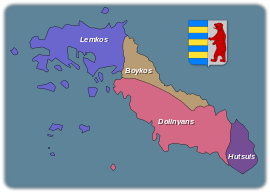
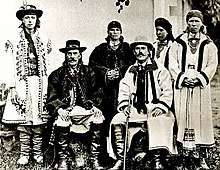



_..jpg)
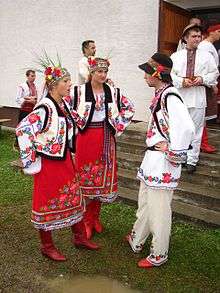
_and_Przemy%C5%9Bl_area_Ukrainians_in_original_goral_folk-costumes..jpg)
